


xxxxxThe French painter Henri de Toulouse-Lautrec suffered a serious, congenital illness as a child. This stunted the growth of his legs and gave him a dwarfish appearance. However, determined to become a painter, he received instruction in Paris and then, in 1884, went to live in Montmartre, the city’s Bohemian quarter. It was here that he spent the rest of his life, recording and taking part in the sordid life surrounding the dance halls, night clubs and brothels of the area. His bold and witty drawings of the cabaret stars, artists, clowns and prostitutes who worked in this “midnight civilisation” quickly gained him recognition, and in 1891, following the opening of the famous Moulin Rouge dance hall, he began designing and producing a series of striking posters to advertise the various places of entertainment. This extended his fame beyond Montmartre. His work was influenced by the likes of Edgar Degas and Édouard Manet, and he owed much to the design of Japanese woodprints. However, by his skill as a draughtsman, he developed a highly individual style, using a brush to produce fresh, vigorous images that captured the distinctive characteristics of people and places. Among those whom he met during his work in Montmartre was the French artist Vincent van Gogh and the Irish author Oscar Wilde, whose portrait he painted in 1895. It was soon after this that his health began to deteriorate, due to his heavy drinking and the increasing effect of syphilis. He spent some time in a private clinic, and died of a severe stroke in September 1901, aged 36.
HENRI DE TOULOUSE - LAUTREC 1864 - 1901
(Vb, Vc, E7)
Acknowledgements
Toulouse-Lautrec: Self-portrait, 1882; La Goulue (poster) – Musée Toulouse-Lautrec, Albi, France; Jan Avril (poster) – Musée Toulouse-Lautrec, Albi, France; German Babylon (poster) – Victoria and Albert Museum, London; La Revue Blanche (poster) – Musée Toulouse-Lutrec, Albi, France; Divan Japonais (poster) – Musée Toulouse-Lautrec, Albi, France; Aristide Bruant (poster) – Musée Toulouse-Lautrec, Albi, France; Au Cirque – Art Institute of Chicago, IL; The Hangover – Fogg Art Museum, Harvard University, Cambridge, MA; The Salon – Musée Toulouse-Lautrec, Albi, France; Moulin Rouge – Museum of Art, Philadelphia, PA; Self-Caricature before an Easel (drawing) – Musée Toulouse-Lautrec, Albi, France; Portrait of Oscar Wilde – private collection. Valadon: Reclining nude – Metropolitan Museum of Art, New York. Rousseau: Tiger in a Tropical Storm – National Gallery, London; Sleeping Gypsy – Museum of Modern Art, New York; Boy on the Rocks – National Gallery of Art, Washington; The Dream – The Museum of Modern Art, New York.
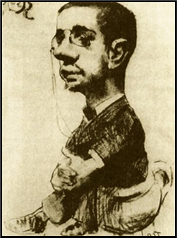 xxxxxThe French painter Henri de Toulouse-Lautrec is remembered the world over as the artist who, by his sketch-like paintings and bold, colourful posters, provided a fascinating glimpse into the gaudy Parisian night life of the “naughty nineties”, realistically captured amid the theatres, dance-halls, night- clubs and the brothels of Montmartre, the bohemian quarter in the north of the city. Labelled a post-impressionist - mainly for his use of pure, brilliant colours and his choice of everyday subjects - his work contributed a great deal to the development of Art Nouveau, a style then having an impact in general on art, architecture and the decorative arts.
xxxxxThe French painter Henri de Toulouse-Lautrec is remembered the world over as the artist who, by his sketch-like paintings and bold, colourful posters, provided a fascinating glimpse into the gaudy Parisian night life of the “naughty nineties”, realistically captured amid the theatres, dance-halls, night- clubs and the brothels of Montmartre, the bohemian quarter in the north of the city. Labelled a post-impressionist - mainly for his use of pure, brilliant colours and his choice of everyday subjects - his work contributed a great deal to the development of Art Nouveau, a style then having an impact in general on art, architecture and the decorative arts.
xxxxxToulouse-Lautrec was born in Albi in south-west France, a descendant of one of the country’s most aristocratic families. His life was tragically affected in his mid-teens when he broke both legs in separate accidents. Because of a congenital calcium deficiency, the bones did not heal and remained stunted for the rest of his life, restricting his height to five feet and giving him a dwarfish appearance. During the long periods of convalescence this condition required, his mother encouraged him to paint and, having shown some talent as an artist, he was sent to Paris in 1882 to take lessons with two academic painters, first with Léon Bonnat and then Fernand Cormon. It was while being taught by Cormon that he met the young Vincent van Gogh.
xxxxxHowever, Toulouse-Lautrec did not take kindly to instruction, being anxious to follow his own artistic ideas. With this in mind, in 1884 he went to live in Montmartre - not with the approval of his parents - and over the next ten years or so became immersed in the life of this Bohemian quarter. He spent his days - or rather his nights - endlessly painting and sketching the cabaret stars, artists, clowns and prostitutes who thronged this demimonde. By his fascination for this world of dance halls, night clubs and brothels, he provided a brilliant tell-tale picture of what has been called “midnight civilisation”. Thesexbold and witty drawings and paintings - many bordering on caricature - quickly gained him recognition, thanks in the main to his friendship with a singer and composer named Aristide Bruant (1851-1925) (featured on one of the posters below). He asked him to produce illustrations for some of his songs and offered his own cabaret, Le Mirliton, as a place where he could display his work. As a result commissions started to come in and his fame spread. In 1888 his works were well received at the Exposition of the Twenty in Brussels (a score of avant-garde artists), and a year later at the Salon des Indépendants in Paris. And with the opening of the famous Moulin Rouge around this time, his work took on another dimension. In 1891 he was asked to design a poster to advertise this dance hall, and his success in this new medium brought him fame well beyond the confines of Montmartre.
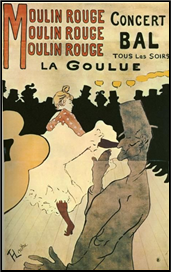
xxxxxHis first poster (here illustrated), featuring the can-can dancer known as La Goulue (The Glutton) or The Queen of Montmartre, was an instant success. “My poster”, he proudly announced, “is pasted today on the walls of Paris”. He went on to compete over 300 striking posters or coloured lithographs, among which were eleven produced for Le Café Concert, sixteen depicting the singer and actress Yvette Guilbert, and an outstanding series entitled Elles, which, completed in 1896, provided a sympathetic portrayal of the sordid lives led by the local prostitutes. Notable in this respect was Au salon de la rue des Moulins (illustrated below), a work highlighting the lonely and monotonous lives these women actually led.
Vc-1881-1901-Vc-1881-1901-Vc-1881-1901-Vc-1881-1901-Vc-1881-1901-Vc-1881-1901-Vc
Including:
Henri Rousseau

xxxxxIn his painting Toulouse-Lautrec developed a highly individual style, but in some elements of his informal composition he was clearly influenced by the works of Edgar Degas - and, to some extent, by those of Édouard Manet. Unlike Degas, however, he captured movement by means of free flowing lines and bold colour. To avoid static positions, lines were casually drawn, and he used strong colours in juxtaposition in order to create the sensation of rhythm. As an Impressionist at heart, he made no attempt at achieving detail, but with a minimum of well-planned brushstrokes he succeeded in capturing the psychological makeup of his cast of varied characters, be they working in a brothel, theatre, circus or music hall. He aimed, as he put it, to depict the truth, not the ideal. Later, in his posters and coloured lithographs - outstanding for their simple clear-cut lines, dramatic layout, and large flat areas of a single colour - he owed much to the design and technique of the Japanese wood print, brilliantly assimilated 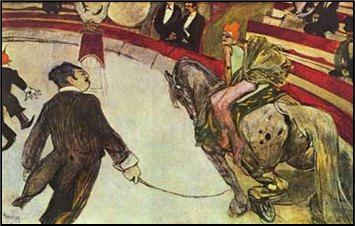 and adapted to suit his own personal expression. It was mainly through his unique technical skill that colour lithography became a recognised art form.
and adapted to suit his own personal expression. It was mainly through his unique technical skill that colour lithography became a recognised art form.
xxxxxIn 1896, however, the year Elles was completed, the life of debauchery which he had not only documented but had also indulged in, brought about a gradual deterioration in both his physical and mental state. In 1898 he did manage to exhibit some of his works in London - during which time he met the Prince of Wales - but the exhibition was a total failure. It was clear that his colourful career was coming to an end. In 1899 syphilis and his heavy drinking eventually resulted in a complete break down in his health, and he was committed to a private clinic for alcoholism at Neuilly, just outside Paris. There, over a period of several months, he painted and drew from memory racing scenes and pictures from his series Au Cirque that he had originally produced in 1888 (illustrated). In 1901, soon after joining his mother at the family château at Malromé, he suffered a severe stroke and died a sad and broken figure in the September at the age of 36. He was buried nearby in Verdelais, Gironde, and in 1922 a museum dedicated to his life and work was established at Albi, his birthplace. This contains the largest collection of his works.
xxxxxIllustrated here are: The Hangover - portrait of Suzanne Valadon (mentioned below), Au Salon de la rue des Moulins (mentioned above), and Dance at the Moulin Rouge.
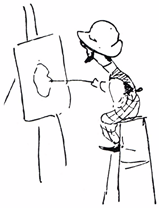 xxxxxToulouse-Lautrec excelled as a draughtsman and this was the basic reason for his success as an artist. Many of his drawings - often executed with a touch of humour - came close to caricature, but, in fact, all his works were carefully prepared, and based on numerous drawings and jottings. Using a thin mixture of paint - peinture à l’essence - he drew with a brush, swiftly producing fresh, vigorous images that captured the distinctive characteristics of his friends and acquaintances, and portrayed their various activities with the minimum of detail. In public he tended to make light and even fun of his infirmity, as this self-portrait shows, but he was a sensitive man, and his private letters reveal that he was highly conscious of his deformed appearance and the blight it placed upon his life. However, despite his deformity and his heavy drinking - it is said that he helped to popularize the American “cocktail” - he produced, in his short and narrow life, a wealth of paintings, drawings, posters, lithographs and etchings. And these works, testimonials to his highly original style and his rare ability to capture mood and personality, influenced the likes of Vincent van Gogh and George Seurat, and played an important part in shaping avant-garde art well into the 20th century.
xxxxxToulouse-Lautrec excelled as a draughtsman and this was the basic reason for his success as an artist. Many of his drawings - often executed with a touch of humour - came close to caricature, but, in fact, all his works were carefully prepared, and based on numerous drawings and jottings. Using a thin mixture of paint - peinture à l’essence - he drew with a brush, swiftly producing fresh, vigorous images that captured the distinctive characteristics of his friends and acquaintances, and portrayed their various activities with the minimum of detail. In public he tended to make light and even fun of his infirmity, as this self-portrait shows, but he was a sensitive man, and his private letters reveal that he was highly conscious of his deformed appearance and the blight it placed upon his life. However, despite his deformity and his heavy drinking - it is said that he helped to popularize the American “cocktail” - he produced, in his short and narrow life, a wealth of paintings, drawings, posters, lithographs and etchings. And these works, testimonials to his highly original style and his rare ability to capture mood and personality, influenced the likes of Vincent van Gogh and George Seurat, and played an important part in shaping avant-garde art well into the 20th century.
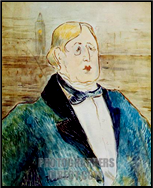
xxxxxIncidentally, his presence in Montmartre attracted a number of visitors from the artistic and literary world. Among these were Vincent van Gogh and the Irish author Oscar Wilde, whose portrait Toulouse-Lautrec had painted at the time of Wilde’s sensational trial in London in 1895 (illustrated here). ……
xxxxx…… In the printing of his lithographs - a process he always supervised - Toulouse-Lautrec introduced a new technique known as crachis or “spitting”. By flicking ink on to the lithographic stone with the aid of a toothbrush, he created a unique speckled or mottled effect in some areas of his posters. ……
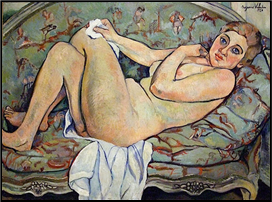 xxxxx…… AmongxToulouse-Lautrec’s many lovers was Suzanne Valadon (1867-1938) (portrait above). A close friend of Edgar Degas and a one-time mistress of Pierre-Auguste Renoir, she worked as a model before becoming a painter in her own right and gaining some success. She painted still-life, portraits and landscapes in strong, vibrant colours, but became best known for her candid female nudes (example illustrated). Her illegitimate son, born when she was sixteen, became the artist Maurice Utrillo, famous for his street scenes of Montmartre.
xxxxx…… AmongxToulouse-Lautrec’s many lovers was Suzanne Valadon (1867-1938) (portrait above). A close friend of Edgar Degas and a one-time mistress of Pierre-Auguste Renoir, she worked as a model before becoming a painter in her own right and gaining some success. She painted still-life, portraits and landscapes in strong, vibrant colours, but became best known for her candid female nudes (example illustrated). Her illegitimate son, born when she was sixteen, became the artist Maurice Utrillo, famous for his street scenes of Montmartre.
xxxxxAnother French post-impressionist at this time was the amateur painter Henri Rousseau (1844-1910). He produced one of his major works, Tropical Storm with a Tiger, in 1891. After retiring as a customs officer in 1885, he produced portraits, scenes of Paris and exotic jungle scenes, but his flat, primitive designs, bold colours and stiff, passive figures were ridiculed for their childish appearance and lack of perspective and proportion. However, a number of artists, including his fellow countrymen Henri de Toulouse-Lautrec, Edgar Degas, George Seurat and Paul Gauguin, admired his imaginative powers and the freshness of his vision, and his works influenced avant-garde artists, such as his friend Pablo Picasso. Today he is chiefly remembered for his exotic jungle scenes, fantasy landscapes of a savage but enchanting world, full of strong colours, lush foliage, and wild animals. Among his best-known works are The Sleeping Gypsy, Jungle with a Lion, The Snake Charmer, The Football Players and The Dream.
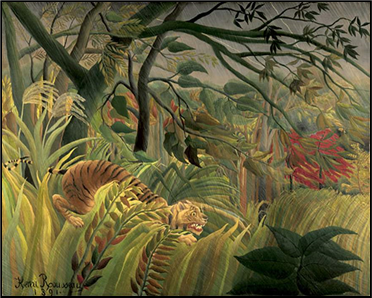 xxxxxAnother French post-impressionist who needs to be mentioned at this time is the amateur painter Henri Rousseau (1844-1910). In 1891 he produced one of his best known works, Tiger in a Tropical Storm (illustrated), now in the National Gallery, London. Born in Laval in the Loire Valley, he joined the army at 18 and served for four years. After his discharge he became a customs officer in Paris, and, on retirement in 1885, took up full-time painting. Almost totally self-taught, he painted portraits, scenes of the Paris suburbs, and exotic jungle scenes, and his flat, primitive designs, bold colours, and stiff, passive figures very soon attracted attention.
xxxxxAnother French post-impressionist who needs to be mentioned at this time is the amateur painter Henri Rousseau (1844-1910). In 1891 he produced one of his best known works, Tiger in a Tropical Storm (illustrated), now in the National Gallery, London. Born in Laval in the Loire Valley, he joined the army at 18 and served for four years. After his discharge he became a customs officer in Paris, and, on retirement in 1885, took up full-time painting. Almost totally self-taught, he painted portraits, scenes of the Paris suburbs, and exotic jungle scenes, and his flat, primitive designs, bold colours, and stiff, passive figures very soon attracted attention.
xxxxxSave for two occasions, Rousseau exhibited regularly at the Salon des Indépendants from 1886 until his death in 1910. Today he is mostly remembered for his highly original fantasy landscapes of the 1890s. Many of these portrayed a bizarre, make-believe world, conjured up by his own vivid imagination, and visits to the local zoo and botanical gardens. They featured human figures and wild animals, set and often hidden in a dense jungle landscape wherein the lush foliage was bold in colour and exaggerated in size. Lacking in perspective and proportion, their dream-like quality was seen by some as a means of escape to a savage but enchanting world.
xxxxxWhilst these unique works aroused interest, they were generally met with derision. For the most part they were ridiculed for their childish, naïve appearance, and dismissed as the attempts of an amateur. However, a number of discerning artists were attracted by his imaginative powers and the freshness of his vision, created within a patchwork of shape and colour. Among those who came to admire and imitate the innocence and charm of his works were his fellow countrymen Henri de Toulouse-Lautrec, Edgar Degas, George Seurat and Paul Gauguin. And his unique style also had an increasing influence upon avant-garde artists, such as his friend, the famous Spanish painter and sculptor Pablo Picasso, and the Surrealists.
xxxxxHis early works included Landscape with Bridge, Wagon in Front of the Mill, Forest Promenade and A Carnival Evening. Among his best-known works are Jungle with a Lion, The Snake Charmer, The Football Players and the three illustrated above: The Sleeping Gypsy, The Boy on the Rocks, and his last fantasy The Dream, a huge painting showing a nude female reclining on a couch in a dense jungle setting.









 xxxxxThe French painter Henri de Toulouse-
xxxxxThe French painter Henri de Toulouse-

 and adapted to suit his own personal expression. It was mainly through his unique technical skill that colour lithography became a recognised art form.
and adapted to suit his own personal expression. It was mainly through his unique technical skill that colour lithography became a recognised art form.  xxxxxToulouse-
xxxxxToulouse-
 xxxxx…… AmongxToulouse-
xxxxx…… AmongxToulouse- xxxxxAnother French post-
xxxxxAnother French post-




